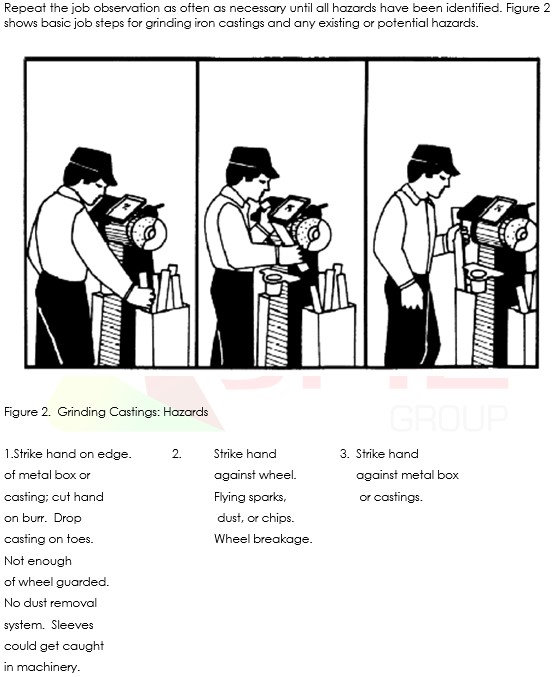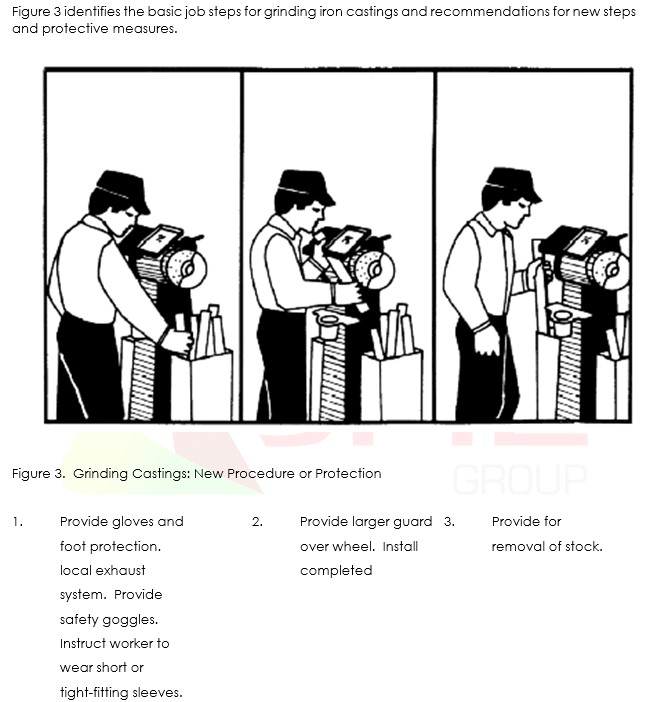Identify Hazards
After you have recorded the job steps, examine each step to determine the hazards that might occur. Ask yourself these kinds of questions.
- Are there hazards that would require the use of personal protective clothing and equipment that are appropriate for the job?
- Are work positions, machinery, pits or holes, and hazardous operations adequately guarded?
- Are lockout procedures used for machinery deactivation as required?
- Is the worker wearing clothing or jewellery, or has long hair that could get caught in the machinery or otherwise cause a hazard?
- Are there fixed objects that may cause injury, such as sharp edges?
- Is the flow of work organized (e.g., Is the worker required to make movements that are too rapid)?
- Can the worker get caught in or between moving parts?
- Can the worker be injured by reaching over moving machinery parts or materials?
- Is the worker at any time in an off-balance position?
- Is the worker positioned to the machine in a way that is potentially dangerous?
- Is the worker required to make movements that could lead to or cause hand or foot injuries, or strain from lifting the hazards of repetitive motions?
- Can the worker be struck by an object or lean against or strike a machine part of the object?
- Can the worker fall from one level to another?
- Can the worker be injured from lifting or pulling or carrying heavy objects?
- Do environmental hazards (dust, chemicals, radiation, welding rays, heat, or excessive noise) result from the performance of the job?

Recommending Safe Procedures and Protection
After you have listed each hazard or potential hazard and have reviewed them with the employee performing the job, determine whether the job could be performed in another way to eliminate the hazards, such as combining steps or changing the sequence, or whether safety equipment and precautions are needed to control the hazards. An alternative or additional procedure is to videotape the worker performing his or her job and analyze the job procedures.
If safer and better job steps can be used, list each new step, such as describing a new method for disposing of the material. List exactly what the worker needs to know to perform the job using a new method. Do not make general statements about the procedure, such as “Be Careful.” Be as specific as you can in your recommendations.
You may wish to set up a training program using the job safety analysis to retrain your employees in the new procedures, especially if they are working with highly toxic substances or in hazardous situations. (Some OSHA standards require that formal training programs be established for employees.)
If no new procedure can be developed, determine whether any physical changes such as redesigning equipment, changing tools, adding machine guards, personal protective equipment, or ventilation will eliminate or reduce the danger.
If hazards are still present, try to reduce the necessity for performing the job or the frequency of performing it.
Go over the recommendations with all employees performing the job. Their ideas about the hazards and proposed recommendations may be valuable. Be sure that they understand what they are required to do and the reasons for the changes in the job procedures.

Revising the Job Safety Analysis
A job safety analysis can do much toward reducing accidents and injuries in the workplace, but it is only effective if it is reviewed and updated periodically. Even if no changes have been made in a job, hazards that were missed in an earlier analysis could be detected.
If an illness or injury occurs on a specific job, the job safety analysis should be reviewed immediately to determine whether changes are needed in the job procedure. In addition, if a close call or near miss has resulted from an employee’s failure to follow job procedures, this should be discussed with all employees performing the job.
Any time a job hazard analysis is revised, training in the new job methods, procedures, or protective measures should be provided to all employees affected by the changes. A job safety analysis also can be used to train effectively new employees on the steps and job hazards.